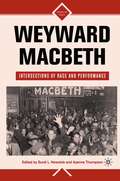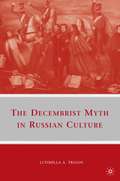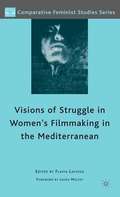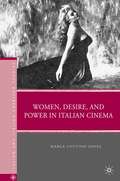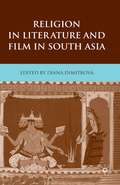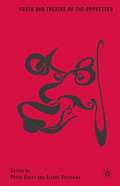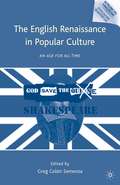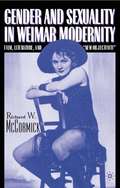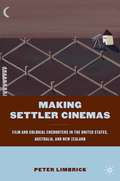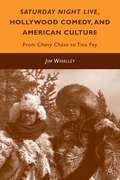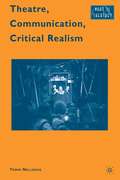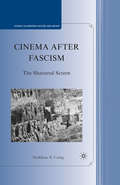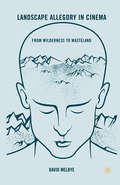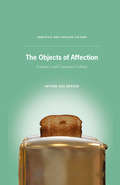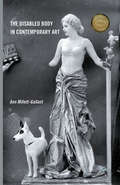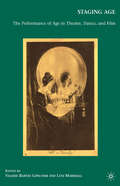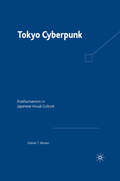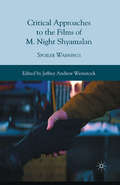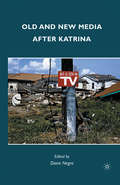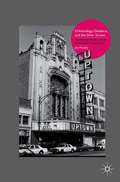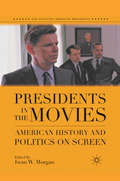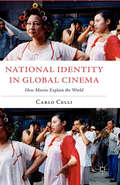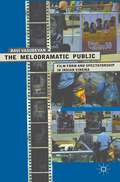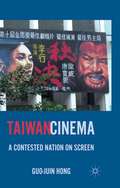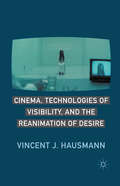- Table View
- List View
Weyward Macbeth: Intersections of Race and Performance (Signs of Race)
by Ayanna Thompson S. NewstokWeyward Macbeth, a volume of entirely new essays, provides innovative, interdisciplinary approaches to the various ways Shakespeare's 'Macbeth' has been adapted and appropriated within the context of American racial constructions. Comprehensive in its scope, this collection addresses the enduringly fraught history of 'Macbeth' in the United States, from its appearance as the first Shakespearean play documented in the American colonies to a proposed Hollywood film version with a black diasporic cast. Over two dozen contributions explore 'Macbeth's' haunting presence in American drama, poetry, film, music, history, politics, acting, and directing — all through the intersections of race and performance.
The Decembrist Myth in Russian Culture
by L. TrigosThis book is the first interdisciplinary treatment of the cultural significance of the Decembrists' mythic image in Russian literature, history, film and opera in a survey of its deployment as cultural trope since the original 1825 rebellion and through the present day.
Visions of Struggle in Women's Filmmaking in the Mediterranean (Comparative Feminist Studies)
by F. LaviosaThis provocative collection elaborates a trans-cultural definition of being a woman in struggle. Looking at the films of women directors in countries in the Mediterranean rim, this book spurs a contemporary discussion of women s human, civil, and social rights while situating feminist arguments on women s identity, roles, psychology and sexuality. Although their methodologies are diverse, these artists are united in their use of cinema as a means of intervention, taking on the role as outspoken and leading advocates for women s problems. Contributors examine the ways in which cinematic art reproduces and structures the discourses of realism and represents Mediterranean women s collective experience of struggle.
Women, Desire, and Power in Italian Cinema (Italian and Italian American Studies)
by M. Cottino-JonesWomen, Desire, and Power in Italian Cinema offers, for the first time in Italian Cinema criticism, a contextual study of the representation of women in twentieth-century Italian films. Marga Cottino-Jones argues that the ways women are depicted on screen reflects a subconscious "sexual conservatism" typical of an Italian society rooted within a patriarchal ideology. The book then follows the slow but constant process of social awareness in the Italian society through women in film, especially after the 1950s. Comprehensive in scope, this book analyzes the films of internationally known male and female directors, such as Antonioni, Fellini, Rossellini, Visconti, Bertolucci, Benigni, Cavani, Wertmuller, Comencini, and Archibugi. Special consideration is given to the actresses and actors that have become the icons of Italian femininity and masculinity, such as Sofia Loren, Gina Lollobrigida, Silvana Mangano, Gian Carlo Giannini, Marcello Mastroianni, and Alberto Sordi.
Religion in Literature and Film in South Asia
by Diana DimitrovaThis innovative, interdisciplinary collection of essays by scholars based in Europe and the United States offers stimulating approaches to the role played by religion in present-day South Asia.
Youth and Theatre of the Oppressed
by P. Duffy E. VettrainoYouth and Theatre of the Oppressed investigates a performance strategy which aims to develop possible alternatives to oppressive forces in individual s lives. Eminent contributors offer diverse perspectives on the theories and practices within Theatre of the Oppressed, especially as it relates to young people. This book shares TO s goal of engaging the collective to create generative conversations among readers which look deeply into the issues of community through theatre - whether in India or Indiana - and to work with young people to name their world, untangle the knot of oppressions, and to develop with them possible action plans for their own futures.
The English Renaissance in Popular Culture: An Age for All Time (Reproducing Shakespeare)
by G. SemenzaThis book considers popular culture's confrontations with the history, thought, and major figures of the English Renaissance through an analysis of 'period films,' television productions, popular literature, and punk music.
Gender and Sexuality in Weimar Modernity: Film, Literature, and “New Objectivity”
by R. McCormickRichard McCormick takes a fresh look at the crisis of gender in Weimar Germany through the analysis of selected cultural texts, both literary and film, characterized under the label 'New Objectivity'. The 'New Objectivity' was characterized by a sober and unsentimental embrace of urban modernity, in contract to Expressionism's horror of technology and belief in 'auratic' art. This movement was profoundly gendered - the epitome of the 'New Objectivity' was the 'New Woman' - working, sexually emancipated, and unsentimental. The book traces the crisis of gender identities, both male and female, and reveals how a variety of narratives of the time displaced an assortment of social anxieties onto sexual relations.
Making Settler Cinemas: Film and Colonial Encounters in the United States, Australia, and New Zealand
by P. LimbrickThrough a shrewd analysis of the historical experience of imperialism and settler colonialism, Limbrick draws new conclusions about their effect on cinematic production, distribution, reception and filmic discourse.
Saturday Night Live, Hollywood Comedy, and American Culture: From Chevy Chase to Tina Fey
by J. WhalleySaturday Night Live, Hollywood Comedy, and American Culture sheds new light on the ways in which Saturday Night Live s confrontational, boundary-pushing approach spilled over into film production, contributing to some of the biggest hits in Hollywood history, such as National Lampoon s Animal House, Ghostbusters, and Beverly Hills Cop. Jim Whalley also considers how SNL has adapted to meet the needs of subsequent generations, launching the film careers of Mike Myers, Adam Sandler, Will Ferrell and others in the process. Supported by extensive archival research, some of Hollywood s most popular comedians are placed into the contexts of film and television comic traditions and social and cultural trends in American life.
Theatre, Communication, Critical Realism (What is Theatre?)
by T. NellhausFrom oral culture, through the advent of literacy, to the introduction of printing, to the development of electronic media, communication structures have radically altered culture in profound ways. As the first book to take a critical realist approach to culture, Theatre, Communication, Critical Realism examines theatre and its history through the interaction of society s structures, agents, and discourses. Tobin Nellhaus shows that communication structure - a culture s use and development of speech, handwriting, printing, and electronics - explains much about why, when, and how theatre has transformed.
Cinema after Fascism: The Shattered Screen (Studies in European Culture and History)
by S. CraigCinema After Fascism considers how postwar European films glance ambivalently backward from the postwar period to the fascist era and delves into issues of gender certainties and spectatorship. In this period of film, familiar structures of epistemology and historiography reappear as ghostly imprints on postwar celluloid, and the remnants of fascist subjectivity walk the streets of postwar cities. Through new perspectives on the films of Roberto Rossellini, Billy Wilder, Carol Reed, Alain Resnais, and Marguerite Duras, this book examines the ways in which filmmakers acknowledge the fascist past. Siobhan S. Craig reveals that the attempts to reconfigure the idioms of cinema are never fully naturalized and remain highly precarious constructions.
Landscape Allegory in Cinema: From Wilderness to Wasteland
by D. MelbyeThis study seeks to understand the form of cinematic space referred to as 'the landscape of the mind,' in which natural, outdoor settings serve as outward manifestations of characters' inner subjective states.
The Objects of Affection: Semiotics and Consumer Culture (Semiotics and Popular Culture)
by A. BergerIn this book, pre-eminent semiotician Arthur Asa Berger decodes the meanings of common objects of consumption and their perceived 'sacredness' in consumerist cultures. Using semiotic theory, consumer culture is dissected in new and fascinating ways.
The Disabled Body in Contemporary Art
by Ann Millett-GallantThis volume analyzes the representation of disabled and disfigured bodies in contemporary art and its various contexts, from art history to photography to medical displays to the nineteenth- and twentieth-century freak show.
Staging Age: The Performance of Age in Theatre, Dance, and Film
by Valerie Barnes Lipscomb & Leni MarshallThis text explores how performers offer conscious-and unconscious-portrayals of the spectrum of age to their audiences. It considers a variety of media, including theatre, film, dance, advertising, and television, and offers critical foundations for research and course design, sound pedagogical approaches, and analyses.
Tokyo Cyberpunk: Posthumanism in Japanese Visual Culture
by Steven T. BrownEngaging some of the most canonical and thought-provoking anime, manga, and science fiction films, Tokyo Cyberpunk offers insightful analysis of Japanese visual culture. Steven T. Brown draws new conclusions about the cultural flow of art, as well as important technological issues of the day.
Critical Approaches to the Films of M. Night Shyamalan: Spoiler Warnings
by Jeffrey Andrew WeinstockCritical Approaches to the Films of M. Night Shyamalan represents the first serious academic engagement with auteur director M. Night Shyamalan and his work. The essays, including contributions from established film scholars David Sterritt, Murray Pomerance, Emmanuel Burdeau, R. Barton Palmer, Matt Hills, and Katherine Fowkes, explore the Hollywood blockbusters from The Sixth Sense to The Happening in terms of their themes, aesthetics, and marketing. Taken together, the collection recognizes and explores Shyamalan s "star status" and offers the concerted analysis that this cultural phenomenon requires.
Old and New Media after Katrina
by Diane NegraTen years after Hurricane Katrina, this thoughtful collection of essays reflects on the relationship between the disaster and a range of media forms. The assessments here reveal how mainstream and independent media have responded (sometimes innovatively, sometimes conservatively) to the political and social ruptures "Katrina" has come to represent. The contributors explore how Hurricane Katrina is positioned at the intersection of numerous early twenty-first century crisis narratives centralizing uncertainties about race, class, region, government, and public safety. Looking closely at the organization of public memory of Katrina, this collection provides a timely and intellectually fruitful assessment of the complex ways in which media forms and national events are hopelessly entangled.
Criminology, Deviance, and the Silver Screen: The Fictional Reality and the Criminological Imagination
by J. FrauleyThis text argues for the usefulness of fictional realities for criminological theorizing and analysis. It illustrates that a creative and critical social scientific practice requires craft norms rather than commercial norms that threaten to completely colonize higher education.
Presidents in the Movies: American History and Politics on Screen (The Evolving American Presidency)
by Iwan W. MorganCinematic depictions of real U.S. presidents from Abraham Lincoln to George W. Bush explore how Hollywood movies represent American history and politics on screen. Morgan and his contributors show how films blend myth and reality to present a positive message about presidents as the epitome of America's values and idealism until unpopular foreign wars in Vietnam and Iraq led to a darker portrayal of the imperial presidency, operated by Richard Nixon and Bush 43. This exciting new collection further considers how Hollywood has continually reinterpreted historically significant presidents, notably Abraham Lincoln, Theodore Roosevelt, and Franklin D. Roosevelt, to fit the times in which movies about them were made.
National Identity in Global Cinema: How Movies Explain the World
by C. CelliWhen themes of historical and cultural identity appear and repeat in popular film, it is possible to see the real pulse of a nation and comprehend a people, their culture and their history. National Identity in Global Cinema describes how national cultures as reflected in popular cinema can truly explain the world, one country at a time.
The Melodramatic Public: Film Form and Spectatorship in Indian Cinema
by R. VasudevanWhat does it mean to say Indian movies are melodramatic? How do film audiences engage with socio-political issues? What role has cinema played in the emergence of new economic forms, consumer cultures and digital technologies in a globalizing India? Ravi Vasudevan addresses these questions in a wide-ranging analysis of Indian cinema.
Taiwan Cinema: A Contested Nation on Screen
by G. HongA groundbreaking study of Taiwan cinema, Hong provides helpful insight into how it is taught and studied by taking into account not only the auteurs of New Taiwan Cinema, but also the history of popular genre films before the 1980s. The book is essential for students and scholars of Taiwan, film and visual studies, and East Asian cultural history.
Cinema, Technologies of Visibility, and the Reanimation of Desire
by V. HausmannExploring the dead/alive figure in such films as The Ring, American Beauty , and The Elephant Man , Vincent Hausmann charts the spectacular reduction of psychic life and assesses calls for shoring up psychic/social spaces that transfer bodily drives to language.
